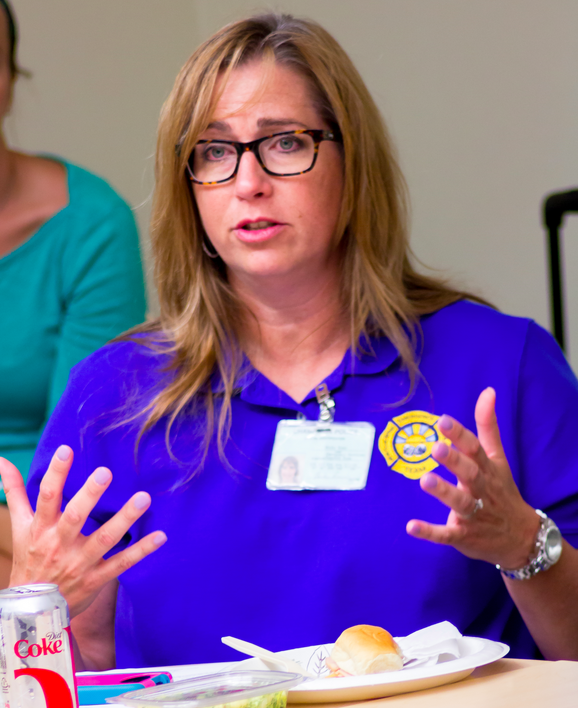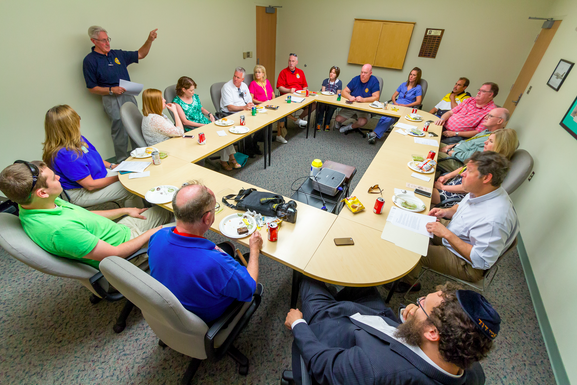After firefighters or police officers leave a crisis scene, there’s still a lot of work to be done. Perhaps a family going through a crisis needs to get in contact with community services, discuss arrangements with a coroner, or find a place to stay for the night. For nearly two decades, the Champaign-Urbana Emergency Services Support Team (ESST) has helped families in these situations negotiate the difficult hours just after an emergency.
Champaign Fire Department Lieutenant Lon Pitcher recalled what it was like before ESST began serving area residents. “Many times, as we were leaving fires, I’d be sitting in the jump seat. People would thank us for our work, and then I’d look back at their house as we drove away. Once we left, there was no one there to help them.”

Pitcher founded ESST in 1996 to address this problem. They haven’t missed a call since 1997, an impressive achievement considering that they serve around 40 families a year and are completely volunteer-run.
A group of roughly twenty-five ESST volunteers provides support 24 hours a day, 365 days a year. They are called to scenes by the fire department or police chief and typically arrive at the scene within 20-25 minutes. They volunteer in 24-hour shifts, from midnight to midnight, with one person acting as a primary respondent and one as a back-up respondent in the case of multiple emergencies. Lon acts as dispatcher, contacting volunteers and supporting them on the scene.
Once they arrive, ESST volunteers’ work varies case-by-case. In one case, Lon made peanut butter and jelly sandwiches for children after a fire. Another time, Becky Rowe, a long-time ESST volunteer who helps Lon manage the organization, helped find a new home for a pet after a death.

“I sometimes joke we’re they’re concierge,” said Rowe. “We’re there to meet their needs for the next 2-3 hours, whatever they may be. Maybe getting them a tissue or glass of water. Maybe guiding them in the direction of making decisions.”
“Once,” Rowe remembered, “an older man asked us if we wanted some coffee when we arrived. His wife had just died, and I could tell he was in shock. He left the room a few minutes later, and I turned the stove off. Part of what we do is help people remember those little things.”
“Another time,” she said, “a child had died in a fire. There was chaos all around. The parents were crumbling. And their other child began asking very specific questions about what would happen to his brother, now that he’d passed away. I was there to begin answering those questions.”
In one case, when Pitcher was the respondent, everything a family owned was destroyed in a fire. “The mother wanted her little girl to go to school the next day,” Lon said. “So I went over to Walmart to buy winter coats for them. I picked out two coats for each of them, but when I got back, the mother told me they only needed one each. She told me someone else might need the extras.”
Having ESST on the scene helps free up the fire department and police so they can move on to the next emergency. ESST’s work is temporary: they typically stay on a scene for a few hours, though Lon and Becky remembered one time when they were in contact with a family in need for nearly four days. This short amount of time provides a bridge between the help people receive from emergency respondents and organizations such as the Red Cross.
“Typically, we’re being called if there’s no other support network in place,” Pitcher said. “We augment the Red Cross because we get a basic assessment of what’s going on, and then we call the Red Cross volunteers, who respond later. They usually either meet us on the scene or at a hotel, where we take folks to get them out of the elements.”
“In a bigger community like this,” Pitcher said, “people might not even know their neighbors. That’s where we come in.”
The backgrounds of ESST volunteers are as varied as a typical neighborhood block. Lon and Becky told me their current volunteer group includes a hairdresser, a minister, a retired financial assistant, an accountant, a maintenance man, a current police officer, an owner of a towing company, a psychologist, a dental hygienist, a schoolteacher, a nurse, and a social worker.

“Everyone has something to offer,” Pitcher said. Rowe agreed that ESST’s varied backgrounds are an asset to their group. “Once, we responded to a call where a small child had died of SIDS. The ESST volunteer who responded had also lost a grandchild to SIDS. It’s invaluable to have someone stand there and say they know what you’re going through.”
Most volunteers join the team because they know Rowe, Pitcher, or someone else from the ESST team.
“I recruited someone at PetSmart once,” Rowe laughed. “I’ll be talking to someone and say, hey, would you like to volunteer for the support team?”
Lon, who described himself as a religious person, said that he believes that the people they need for the team will find them.
“All these people have such good hearts,” Rowe said. “It’s different than volunteering to go to some meetings or serve on a board. You have to be willing to go out in the middle of the night, when it’s -10 degrees, and stand in the freezing rain. And your pen’s not working as your talking to people. It’s not glamorous.”
Despite the difficulty of the work, Pitcher and Rowe said that they have a very small rotation of volunteers. They typically lose and add only about five volunteers per year.
Becky, one of the longest-serving and most active volunteers, recalled being recruited by Pitcher, who reached out to Rowe after talking to her mother about ESST.
“I tend to be a very emotional person,” said Rowe, “and initially I wasn’t sure if I would be able to handle the calls. I was excited to learn there is a place in the world for my emotional sensitivity.”
Becky said she finds the work ESST does to be very intimate. “You’re stepping into someone’s life at the worst possible moment, and there’s no wall there. You are in it with them. And when you’re working with people’s emotions, you don’t just stand there stoically. Sometimes we cry with them. Sometimes our hands hurt afterward from the squeezing.”
Outside of their response calls, ESST volunteers meet once a month for meetings and debriefings. They share recent calls they have responded to and talk through experiences as a group. They also receive specialized trainings, though Lon said all the information is designed for non-experts. “We don’t purport to be counselors, so all of our trainings are in the context of being a layperson.”
And despite the difficulty of their work, Pitcher and Rowe emphasized how rewarding they find it to be.
“One of the gifts of this work is that we come into contact with people we might not otherwise come in tact with,” Pitcher said. “You learn how fortunate you are. It helps to be reminded of that. And when you are fortunate, it is your responsibility to do things for people in your community.”
The Champaign-Urbana Emergency Services Support Team is always seeking new volunteers. For more information, contact the Champaign Fire Department (217-403-8901 or 217-403-8905) or Lon Pitcher (217-202-8381).








